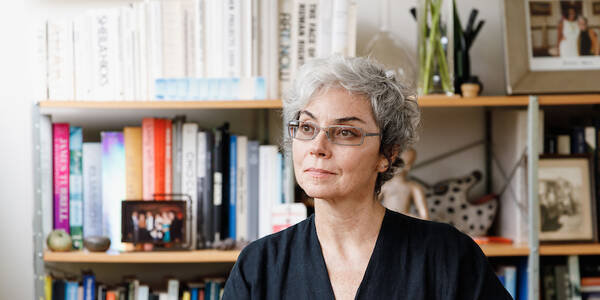
profile / faculty / interaction-design / media-design-practices
September 06, 2019
By: Solvej Schou
Interaction Design and Media Design Practices faculty member Elise Co merges technology and design
In the brightly lit Immersion Lab on ArtCenter’s South Campus, Elise Co sits in front of a computer screen surrounded by students, her right hand encased in a motion-capture glove with sensors attached to the knuckles and wrist.
The Interaction Design and graduate Media Design Practices (MDP) associate professor grips a pen, scribbles in a notebook and stares at the screen. It shows a swirl of color that coincides with her hand movements. The demonstration is part of the Transdisciplinary Studio (TDS) course Body Tracking, taught by Co and Interaction Design and MDP Assistant Professor Jenny Rodenhouse (MFA 15 Media Design). Rodenhouse conceived of the course and is the director of the Immersion Lab, a space with access to AR and VR technologies. In the TDS, students use hands-on prototyping to explore virtual and physical body parts, spatial interactions, sensory devices and wearables.

“I encourage you to be free in how you conceptualize,” Co tells the students. She and Rodenhouse later observe the work of MDP student Tianlu Tang, who shows a video in which a tree is seen from various camera angles. “How is seeing fundamentally part of this, and how do you incorporate the nonvisual side of seeing?” asks Co. A discussion follows about the complex nature of senses and about the camera’s ability to see one object in an endless number of ways.

For 10 years Co has brought this kind of thoughtful and savvy approach to ArtCenter as a faculty member, teaching courses ranging from MDP’s Lab Thesis 1 and 2—focused on individual thesis projects—to the TDS courses Wearable Technology and Body Tracking. She also co-founded the Los Angeles design and technology firm Aeolab with her husband, Nikita Pashenkov. The pair, who work from home, have designed LED display visualizations, electronic prototypes, robotic appliances and multiscreen installations for clients such as Sony, Samsung, BMW and Pasadena’s Jet Propulsion Laboratory. Their prototype for BMW imagining the interior of a future autonomous vehicle was displayed at the consumer technology trade show CES in 2016. For Sony, they built prototypes of a hand crank–powered camera for kids.

“I think of technology as a medium for design and creative expression,” says Co, cupping a glass of hot tea a week later on the front porch of her family’s two-story home in the hills of Echo Park, an L.A. neighborhood 10 miles southwest of South Campus. “Coding or learning electronics is like an artist learning their craft and material,” she says. At the house, books on computer graphics, printmaking and design fill shelves alongside tables covered with computer screens, bins of gadgetry and colorful drawings and paintings by the couple’s three children. A strong breeze whips through a lime tree and rows of succulents outside.
Co didn’t start out as a technology enthusiast. Her parents, both doctors, immigrated to the United States from the Philippines, and Co grew up in Rancho Palos Verdes, where she cultivated a love of sewing and crafts in high school. While she had had the idea since childhood of becoming a neurologist, like her father, she also had the thought as a teenager of becoming a jewelry glass bead maker or a ceramicist, even though “I wasn’t good at it,” she says, laughing. Still, she applied on a whim to the Massachusetts Institute of Technology (MIT) and was accepted.


Co earned an undergraduate degree in architecture at MIT while also working as a research intern at the university’s Media Lab. Afterwards, she earned her master’s degree from MIT’s Media Lab Media Arts and Sciences program, and then did one year of a PhD in the program. She worked for a Boston-based design firm, taught at the Basel School of Design in Switzerland and eventually moved back to California, incorporating Aeolab with Pashenkov in 2006.

“It’s interesting to work with someone who is also your partner in life, and I’m lucky that our collaboration happens so naturally,” Co says.
Co first heard about ArtCenter from her friend and former MDP faculty member Peter Cho. Starting out as a thesis adviser for MDP, she began teaching Interaction Design courses as well several years ago. Body Tracking stemmed from Rodenhouse’s interest in a motion-capture suit, and she invited Co to teach the course with her. “We have students capture 20 motions of doing the same thing, like drinking water or sitting down, and then when you have 20 people doing it, they’re all so different,” says Co.

The practice at ArtCenter of thinking through making most appeals to Co.
“It goes along with my own practice of prototyping, which is part of the design process,” she says. “Even if technology changes, certain methodologies and approaches are always going to be valid. If you’re someone who can find insights, create and be articulate, you’ll be fine.”











